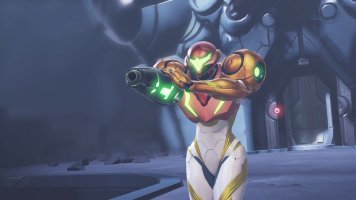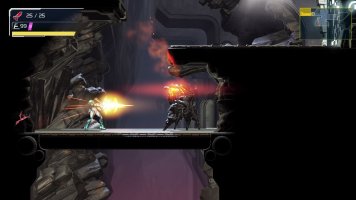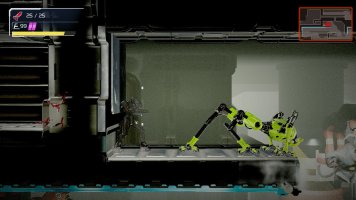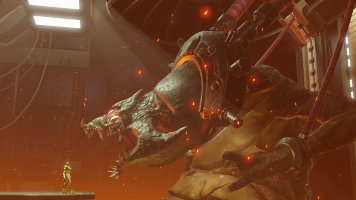Official Review
While it works well handheld, docking the Switch gives you the full 2D Metroid TV experience we've missed since Super Metroid on SNES (though Zero Mission looks great emulated on Virtual Console). On a big HD screen, you'll see vast alien landscapes in diorama-like backgrounds, lit up by Samus's glowing weapons. Thanks to the Switch, the action never slows down. This is crucial, as combat is quick and only gets quicker with each upgrade. As you progress through Dread, everything seems to speed up. New abilities boost your movement and cut down backtracking time, while your growing arsenal makes short work of once-tough enemies.
I had issues with the cramped controls hindering action in the last Metroid game, the 3DS remake of Samus Returns, especially its twitchy combat. That combat style returns in Dread, but the Switch makes it much more comfortable and fun. The counter system from Samus Returns, which needs precise timing to react to enemy tells, is just one of many moves. Dashes, feints, dodges, and timed-charge attacks fill out your toolkit, using up a lot of buttons. It's okay in handheld mode, but Dread really shines with the Pro Controller. For boss fights – and these are some of Metroid's toughest – I always docked the Switch.
The boss battles in Dread are diverse, ranging from classic giant monsters with patterns to learn, to fights reminiscent of Smash Bros. where foes mirror your abilities. This variety is refreshing, especially compared to Samus Returns' repetitive insect bosses. Without spoiling anything, these encounters are some of the best I've experienced in action platformers. Initially seeming impossible, they ultimately improved my skills as a player.
A recurring challenge comes from the eerie EMMI robots, prominently featured in Dread's previews. These encounters are more like stealth missions or frantic escapes when spotted, rather than traditional boss fights. EMMI zones become instant-death areas (with a tiny chance of escape), making the new auto-save feature just outside these zones a welcome addition to the Metroid series.
One aspect of boss fights I'm not fond of is the use of counters as quick-time events - timed button presses needed to progress through fight stages. It's often unclear if you should be attacking the boss while waiting for a counter opportunity. I wish I could use my massive missile stock to defeat bosses the old way; what's the point of collecting all these missile tanks if I can't occasionally overwhelm a boss with sheer firepower?
The hidden collectibles, like missile tanks and other upgrades, are ingeniously placed. Some puzzles are truly perplexing, leaving me pondering between sessions. Aiming for 100% completion showcases the intricate world design. The Speed Booster and Shinespark moves enable mind-bending puzzles and require precise, split-second platforming that's both challenging to figure out and satisfying to execute. Using classic Metroid techniques like bomb jumping, I even managed to "sequence break" and obtain upgrades early, making me feel like a skilled player. This flexibility and freedom made the world more inviting for exploration and experimentation.
For those who aren't completionists, Metroid Dread offers a quicker playthrough option. My first run took about 11 hours, reaching 82% completion according to the game log. This doesn't include time spent on pause screens, which you might use often due to the revamped map. It now tracks mysterious objects you can't interact with, items you've seen but not collected, and rooms with hidden secrets. I frequently studied the map to uncover secrets and plan my next move. Some players might turn to guides for direction, as Metroid Dread doesn't hold your hand in finding objectives. As someone who dislikes excessive guidance, I appreciate this approach, especially in a game that rewards thorough exploration. The new scanning tool strikes a good balance, offering hints for secret paths without being too obvious.
The game world, including the map, changes several times, particularly in later stages. Without spoiling anything, while not as dramatic as Castlevania: Symphony of the Night's upside-down castle, the new routes and enemy challenges you'll face are quite impressive.
I don't think the game needed to be any longer. As my colleague Kat Bailey noted, Samus Returns felt too long, with repetitive bosses and a sprawling map. Dread learns from this, improving the pacing by quickly introducing new tools and areas. You can choose to pause and backtrack or push forward to the end. However, gathering as many upgrades as possible is crucial for the tough boss fights ahead.
One area where Metroid Dread slows down a bit are the transitions between areas - elevators, trams, and teleporters. These act as hidden loading screens, breaking up the world more noticeably than in previous games. This is one instance where the Switch's 2016 hardware limitations become apparent in Dread's ambitious design.
The game allows flexibility in how you approach it. You can rush through for a shorter experience or take your time exploring every nook and cranny. The overhauled map system is a great tool for both styles of play, helping you track items, secrets, and unexplored areas. While the game doesn't explicitly guide you, the map and scanning tool provide just enough information to keep you moving forward without feeling lost.
This year, rumors swirled about the conclusion of a Metroid storyline, and it's even more exciting than you might think. Metroid Dread is the fifth main entry since 1986, not a spinoff like the Prime series. While the story is minimal (a welcome change after missteps like Other M), it supposedly wraps up here. Despite some plot twists, there's a standout moment when Samus does something unexpected. It's subtle, beautiful, and sure to delight fans. This understated approach extends to most of the narrative. The plot is simple: a bounty hunter, harmless but ravenous aliens, and a new reason for losing your powerful gear.
It's refreshing that Dread avoids the awkward world-building of games like Other M. Instead, it narrows its focus to Samus and the Chozo, the vanished birdlike aliens who raised her. This approach echoes series highlights like Metroid Prime and Zero Mission. And while the Chozo's penchant for underground tunnels seems odd for a winged species, we can overlook that detail.
The game's world, including the map, evolves several times, especially in later stages. Without spoiling anything, the new routes and enemy challenges are impressive, though not quite as dramatic as Castlevania: Symphony of the Night's upside-down castle.
The game's length feels just right. Unlike Samus Returns, which felt drawn out with repetitive bosses and a sprawling map, Dread improves pacing by quickly introducing new tools and areas. You can choose to backtrack or push forward, but gathering upgrades is crucial for the tough boss fights ahead.
Verdict
Metroid Dread nails so much after such a long wait that I almost wish we'd gotten this game and a few follow-ups on a regular schedule since 2005. Instead, I'm thrilled to play a Metroid that's back in top form. While it's the newest in an old series, Dread balances familiarity with just enough smart tweaks. The well-known mix of hard puzzles, harder bosses, growing exploration options, and complex level design that recent hits like Hollow Knight and Ori do so well has its roots in Metroid. I enjoy those games, but the Metroid team, blending veteran and new developers, proves they're still the masters of this craft. They've shown they know how to do it best.






